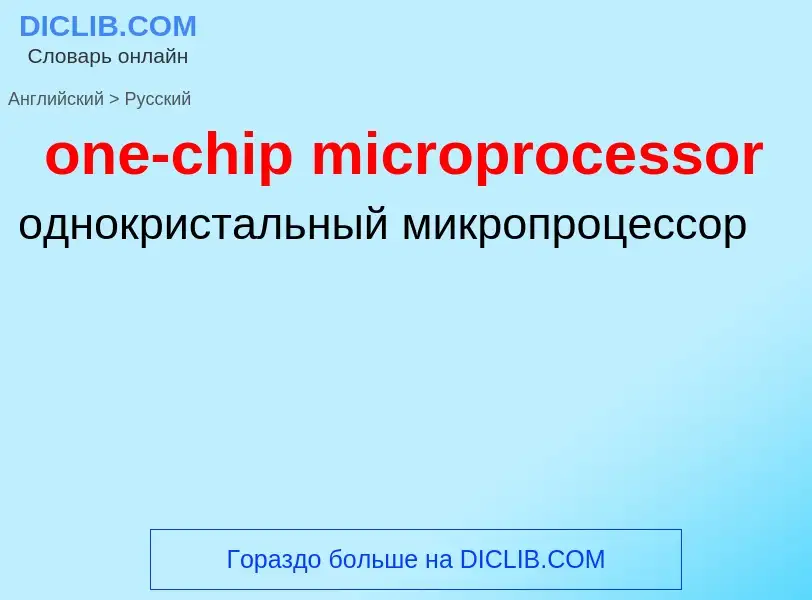Translation and analysis of words by ChatGPT artificial intelligence
On this page you can get a detailed analysis of a word or phrase, produced by the best artificial intelligence technology to date:
- how the word is used
- frequency of use
- it is used more often in oral or written speech
- word translation options
- usage examples (several phrases with translation)
- etymology
one-chip microprocessor - translation to russian
- one-chip microprocessor
- security control microprocessor
- signal microprocessor
[maikrə(u)'prəusesə]
общая лексика
MP, MPU
микропроцессор
центральный процессор, реализованный в виде одной микросхемы. Первый коммерческий микропроцессор был разработан корпорацией Intel в 1972 г
вычислительная техника
микропроцессорный
Смотрите также
существительное
вычислительная техника
микропроцессор
Definition
Wikipedia
ChIP-on-chip (also known as ChIP-chip) is a technology that combines chromatin immunoprecipitation ('ChIP') with DNA microarray ("chip"). Like regular ChIP, ChIP-on-chip is used to investigate interactions between proteins and DNA in vivo. Specifically, it allows the identification of the cistrome, the sum of binding sites, for DNA-binding proteins on a genome-wide basis. Whole-genome analysis can be performed to determine the locations of binding sites for almost any protein of interest. As the name of the technique suggests, such proteins are generally those operating in the context of chromatin. The most prominent representatives of this class are transcription factors, replication-related proteins, like origin recognition complex protein (ORC), histones, their variants, and histone modifications.
The goal of ChIP-on-chip is to locate protein binding sites that may help identify functional elements in the genome. For example, in the case of a transcription factor as a protein of interest, one can determine its transcription factor binding sites throughout the genome. Other proteins allow the identification of promoter regions, enhancers, repressors and silencing elements, insulators, boundary elements, and sequences that control DNA replication. If histones are subject of interest, it is believed that the distribution of modifications and their localizations may offer new insights into the mechanisms of regulation.
One of the long-term goals ChIP-on-chip was designed for is to establish a catalogue of (selected) organisms that lists all protein-DNA interactions under various physiological conditions. This knowledge would ultimately help in the understanding of the machinery behind gene regulation, cell proliferation, and disease progression. Hence, ChIP-on-chip offers both potential to complement our knowledge about the orchestration of the genome on the nucleotide level and information on higher levels of information and regulation as it is propagated by research on epigenetics.




![Upper interconnect layers on an [[Intel 80486]]DX2 die Upper interconnect layers on an [[Intel 80486]]DX2 die](https://commons.wikimedia.org/wiki/Special:FilePath/80486DX2 200x.png?width=200)
![64 bit]] [[x86-64]] processor (AMD Ryzen 5 2600, Based on [[Zen+]], 2018) 64 bit]] [[x86-64]] processor (AMD Ryzen 5 2600, Based on [[Zen+]], 2018)](https://commons.wikimedia.org/wiki/Special:FilePath/AMD Ryzen 5 2600 (39851733273).jpg?width=200)
![AM4]] socket on a motherboard AM4]] socket on a motherboard](https://commons.wikimedia.org/wiki/Special:FilePath/AMD Ryzen 7 1800X.jpg?width=200)


![4004]] with cover removed (left) and as actually used (right) 4004]] with cover removed (left) and as actually used (right)](https://commons.wikimedia.org/wiki/Special:FilePath/C4004 (Intel).jpg?width=200)
![[[Intel 4004]] [[Intel 4004]]](https://commons.wikimedia.org/wiki/Special:FilePath/C4004 two lines.jpg?width=200)


![Intel Core i9-9900K (2018, based on [[Coffee Lake]]) Intel Core i9-9900K (2018, based on [[Coffee Lake]])](https://commons.wikimedia.org/wiki/Special:FilePath/Intel i9-9900K.jpg?width=200)
![[[Motorola 6800]] (MC6800) [[Motorola 6800]] (MC6800)](https://commons.wikimedia.org/wiki/Special:FilePath/Motorola XC6800A 1.jpg?width=200)
